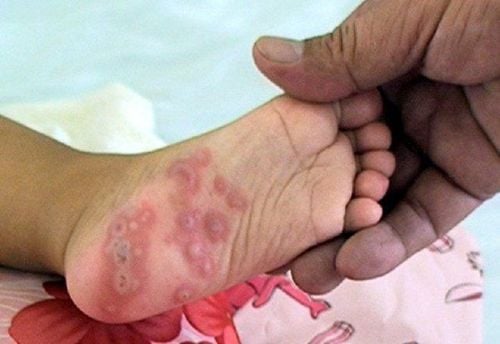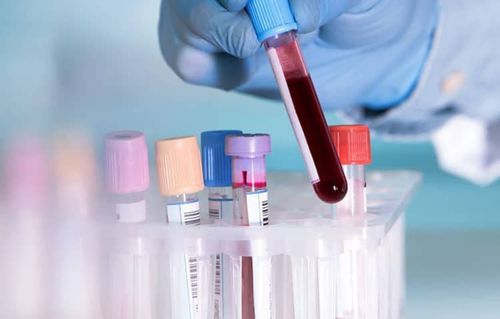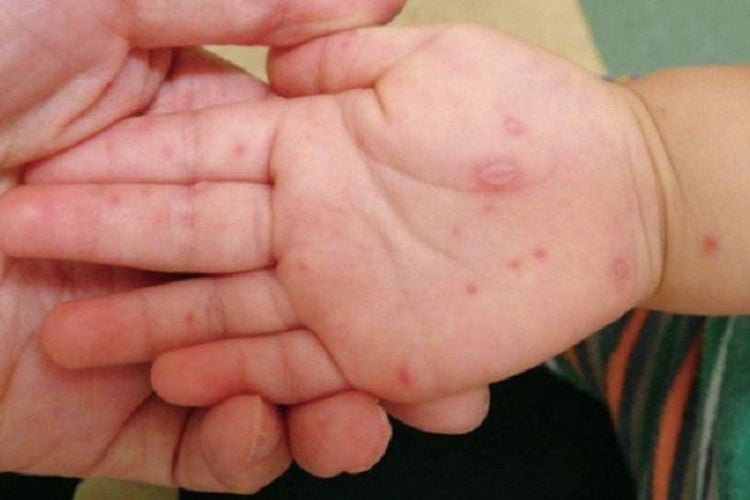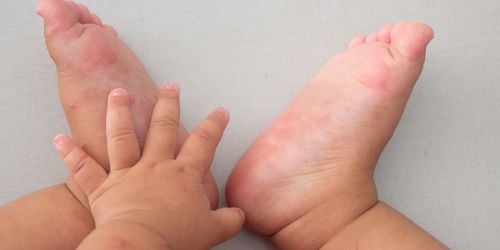This is an automatically translated article.
The article was professionally consulted by Doctor Doan Thi Hong Hanh - Head of Laboratory Department, Vinmec Ha Long International Hospital.Hand, foot and mouth testing is essential for early diagnosis of hand, foot and mouth disease and to limit the occurrence of complications such as meningitis, nerve palsy, acute pulmonary edema... leading to death.
1. Overview of hand, foot and mouth disease
Hand, foot and mouth disease is a disease that can occur at any age, but is common in children under 5 years old, especially in the age group under 3 years old. This is a human-to-human infectious disease caused by Coxsackie virus A16 and Entero virus EV71.
Symptoms of hand, foot and mouth disease include: Skin and mucosal lesions in the form of blisters in special locations such as mouth, palms and soles, buttocks, knees.
The transmission route of hand, foot and mouth disease is mainly the gastrointestinal tract and the main source of transmission is saliva, blisters and feces of infected children. Community factors such as children attending daycare centers and places where children gather to play are risk factors for disease transmission, especially during outbreaks.
Hand, foot and mouth disease in children can cause many dangerous complications such as: encephalitis, weakness or paralysis of the limbs (acute flaccid paralysis), cranial nerve palsies, hypertension, increased muscle tone, myositis With the dangerous complications of hand, foot and mouth disease, testing to diagnose hand, foot and mouth disease is an essential element for early detection and treatment of complications because nowadays There is no specific treatment for the disease, only supportive treatment.

2. Hand, foot and mouth diagnostic tests
2.1. Diagnosis based on tests According to Document No: 1003/QD-BYT Ministry of Health Issued on March 30, 2012 on Guidelines for diagnosis and treatment of hand - foot - mouth disease, depending on severity Of the disease, the child will be given tests to diagnose the corresponding hand, foot and mouth disease such as:
Blood count test. WBCs are usually within normal limits. A white blood cell count of more than 16,000/mm3 or an elevation of blood glucose >160 mg% (8.9 mmol/L) is often associated with complications. The C-reactive protein (CRP) test was within normal limits (< 10 mg/L). Blood sugar test, electrolytes, chest X-ray. The follow-up tests detect complications such as: Blood gases in the presence of respiratory failure; troponin I, echocardiography when tachycardia ≥ 150 beats/min, suspected myocarditis or shock; cerebrospinal fluid (lumbar puncture in the presence of neurological complications or when meningitis cannot be excluded; protein tests normal or elevated, cell count within normal or elevated limits, possibly white blood cell count) mononuclear or polymorphonuclear leukocyte predominance). Tests that help confirm the diagnosis (if possible) from grade 2b or higher or need differential diagnosis include: Taking samples of the pharynx, blisters, rectum, cerebrospinal fluid to perform RT-PCR test or Virus isolation to diagnose the cause. Brain magnetic resonance imaging: Only performed when conditions permit and when there is a need for differential diagnosis with neuropathy.

Mouth: Red spots appear on the child's tongue and inside the mouth. These spots quickly turn into large, grayish-yellow blisters with red borders. Children with the disease may not eat or drink because the blisters in the mouth cause swelling, pain and discomfort. Hands and feet: Small red spots appear on the baby's fingers, back or palms, soles of the feet. This small spot will cause pain and itching, then turn into gray blisters in the middle.

3. Hand, foot and mouth disease prevention
There is currently no vaccine for hand, foot and mouth disease, so to prevent the disease, everyone needs to:
Wash hands often with soap, especially before cooking, feeding children, and after going to the toilet , hygiene for children. Because hand, foot and mouth disease is transmitted through the digestive tract when eating and drinking, it is necessary to eat cooked, drink hot, eating utensils need to be washed before being used... children with soap or common detergents. Do not allow children to come into contact with sick or suspected sick people.
Especially, if the child shows signs of hand, foot and mouth disease, leave the child out of school and take the child to the doctor immediately for a suitable treatment regimen.
Please dial HOTLINE for more information or register for an appointment HERE. Download MyVinmec app to make appointments faster and to manage your bookings easily.










![[Vinmec - Q&A with experts] Number 02: Children's health in hot season (Part 1)](/static/uploads/small_20190723_082829_863235_Banner_FB_1200x628_max_1800x1800_png_982bf67b1c.png)



